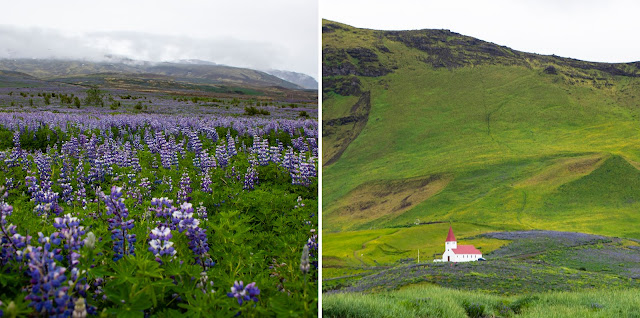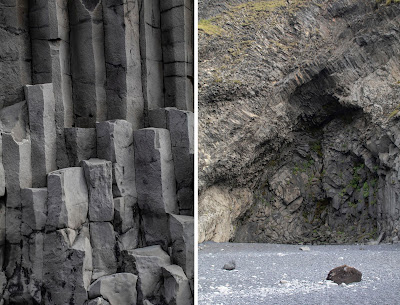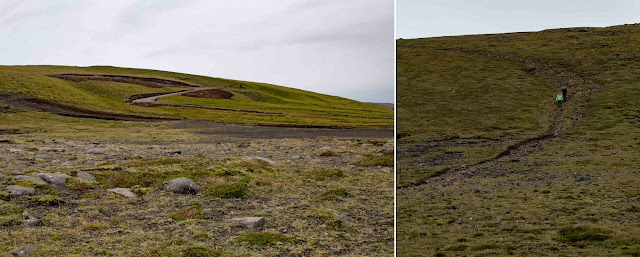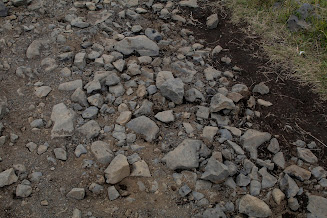Among the coolest places in Iceland is the area around Vík í Mýrdal, which I have blogged about before. This area was a major destination on this trip because it is so spectacular.
 |
| The drive offers up lovely green hills and outcrops |
We had one night booked at a nearby cottage and, then, we were to head back to the Reykjanes peninsula to see the volcano. While we were in the Vík area for the originally scheduled time, we had some rain and overcast, ranging from moderate to "this is really ruining the view" levels.
 |
| No volcano that day! |
And, as we drove away from Reykjanes, the weather got better and better.
 |
| What a difference a day makes |
So, from here on, I am abandoning any concept of chronology and will just talk about sights along the South Coast in Suðurland. Here, I will cover Vík, Reynisfjara, Reynisdrangar and Dyrhólaey.
The town of Vík itself is cute and has a few places to eat.
 |
| Can't beat them |
What makes it traditional?
Steamed hot dog. Steamed bun. Ketchup. A sweet brown mustard called pylsusinnep. Remoulade, a sauce made with mayonnaise, capers, mustard and herbs. Chopped white onions. And, the best part, crispy fried onions. To die for.
But, I digress. Vík's biggest attraction is the black beach with a great view of the sea stacks called Reynisdrangar. I’ll talk about them in a minute.
Northern Fulmars
 |
| Fulmars nest on this cliff; Photo: Scott Stevens |
When we drove into Vík í Mýrdal, we noticed lots of Fulmars sitting on the road and many more that had been run over by cars.
I had seen birds on the road on previous trips to Iceland, but never this many. I also encountered a couple on the beach that obviously couldn’t fly and appeared to even have trouble walking.
 |
| A young Fulmar I encountered |
It turns out that, when Fulmars fledge, they have not yet developed the wing strength to fly. So, they float down from the cliffs where their parents nest and land in the ocean or in streams. When in streams, they strengthen their wings as they float toward the ocean.
Unfortunately, Iceland’s black-top roads look just like streams. So, Fulmars make their way to roads and sit there waiting to be swept to sea. And, cars hit them.
There are signs in town urging people to slow down and watch for the birds (apparently many people didn’t get the memo) and we saw a rescue group scooping the large birds off the asphalt and putting them in boxes, presumable to release somewhere safer.
Vík í Mýrdal
While Vík í Mýrdal is famous for its black beach to the south, one should always look north, too.
 |
| Vík í Mýrdal from the beach |
 |
| Summer, 2019 |
 |
| We had a picnic here |
And, the beach at Vík gives a hint at our next stop.
Famous Sea Stacks and a Special Beach
Next along the road – heading west – is Reynisfjara, the beach with the closest view of Reynisdrangar.
 |
| Reynisfjara and Reynisdrangar from across the bay |
It was a bit overcast (a frequent problem in Iceland) when we went the first time, but it was still breathtaking.
 |
| A wild sea attacking the stacks; Photo: Scott Stevens |
Then, we got some sun.
 |
| The end of the beach closest to the stacks |
This year, Reynisfjara was rated the sixth best beach in the world.
Among its attractions are the black stone beach ...
 |
| Scott walks down the beach |
... a giant basalt cliff ...
 |
| Basalt resulting from a volcanic eruption |
... several caves ...
 |
| The caves sit on the water's edge and can be swamped by the surf; Photo: Scott Stevens |
... and the ability to walk fairly close to the sea stacks (be careful, though, because that part of the beach is underwater at high tide and the ocean here is wild!).
When tide is out, you can still watch waves crash against the shore and Reynisdrangar.
 |
| Wild surf |
And, there is always danger of a sneaker wave (indeed, Scott got hit by a small one, soaking his shoes and pants legs). This was as he was returning from the end of the beach where he got some great photos.
The first time we stopped, I had intended to go to the end of the beach, but got distracted.
I stopped to photograph the ever-present Northern Fulmars (something no one else was doing) and noticed that some were flying awkwardly.
 |
| What are those birds? |
Fledglings finally getting their sea wings? No, that wasn’t right …
Could it be? Puffins!
 |
| Some were flying and others were content to preen in their burrows |
There were hundreds of them flying back and forth from the cliffs above the basalt cave to the ocean.
I assume they were youngsters who were honing their flight skills before heading to sea. Their parents were probably already gone.
 |
| The grayish feathers on the left Puffin's face indicate that it is a youngster |
… and lots …
 |
| It was hard to tell when and where they would take off or land |
 |
| These are just some of my many shots |
 |
| These stair-like rocks are too tempting for some |
A popular tourist area, it is very crowded. It can be tricky to get good photos that don’t require some photoshop work to remove the people. This includes idiots climbing up the basalt blocks (some, in my opinion, too close to the Puffins).
A warning: if you are going to Iceland on a tour, you may have limited time at Reynisfjara. We watched one bus pull in and disgorge its passengers. Within 10 minutes, they were all being called back to reboard. Walking on the rocky beach is a bit tricky and most of the elderly tourists didn’t even have time to pick their way far enough down the beach for a good view of Reynisdrangar.
 |
| Most of the tourists couldn't make it to the close-by caves |
A little about Reynisdrangar, which looks like two stacks from Reynisfjara, is actually three stacks that can be seen from Vík í Mýrdal.
 |
| The perspective from Vík's black beach; Photo: Scott Stevens |
 |
| A view of the full formation on a very calm day; Photo: Guide to Iceland |
 |
| It does look somewhat like a ship |
They began to drag it to shore, but dawn broke before they made it back (another dumb troll story). The trolls and the ship were frozen into stone.
 |
| Drawing: Rovina Cai |
Dyrhólaey
After Reynisdrangar, is Dyrhólaey, formerly known by seamen as Cape Portland. It’s a small promontory formed by a volcanic eruption about 100,000 years ago.
 |
| Dyrhólaey with a lava arch beyond |
Dyrhólaey Lighthouse sits at the top of the 390-foot-tall formation facing the sea.
 |
| What you can see if you go to the top; Photos taken in 2017 |
 |
| The road, left, and the trail; they both appear to be gentle grades |
 |
| Trail rocks |
I made it almost to the top, marveling at how Icelanders like to dump huge rocks on the trail and then post signs to tell you to stay on the trail when the area along the side is much smoother and more even.
Unfortunately, the top of the trail was steep, very rocky and slippery.
I was carrying two cameras and have a pretty serious phobia bout scrambling over rocks. I went higher than I was comfortable and got as close to a panic attack as I had ever gotten. No fun.
 |
| View from the trail |
Would it kill them to put in a handrail at the steep part?
It would have been better if I had just stayed near the parking lot to admire the views ...
 |
| Additional stacks from the lower viewing area; Photo: Scott Stevens |
... and the natural sea arch.
 |
| Natural arch; Photo: Scott Stevens |
In front of Dyrhólaey, there is a gigantic black arch of lava standing in the sea, which gave the peninsula its name: “door hill island.”
 |
| The lava arch |
You can see the arch from Reynisfjara …
 |
| The view on a gray day; Photo: Scott Stevens |
Great views both ways.
 |
| The view on a sunny day; Photo: Scott Stevens |
A Great Cottage
After our two nights at Guesthouse Gerði, we had stayed at Hvoll Cottages for one night.
The Cottages face Dyrhólaey and I was anticipating a fabulous sunset and sunrise.
 |
| A great location; Photo: Booking.com |
 |
| Gray, but still a pretty view |
And watching the Dyrhólaey Lighthouse’s revolving light was pretty cool, even if it was soggy.
 |
| An actual working lighthouse |
The is a path from the Cottages to the beach and, had the weather been good, we might have gotten a great view. But, the mud on the trail was too deep (and the wet cows looked a bit threatening), so we didn’t go.
 |
| The resident dog; Photo: Scott Stevens |
The Cottages also have a resident dog with an obsession for fetch. Apparently, he lost all his balls, so now he brings you stones. After Scott tossed the stone multiple times while waiting to check in, the owner asked us not to play with him because the stones were damaging the dog’s teeth. Maybe just buy him another ball.
If I ever go back, I think I’d opt for two nights at Hvoll Cottages.
 |
| A cozy, well-equipped interior; Photos: Scott Stevens |
With clear skies, the view would be fantastic.
 |
| Even with rain and fog, the view was pretty good |
And, I can just imagine aurora!
Trip date: August 13-September 1, 2021
















No comments:
Post a Comment